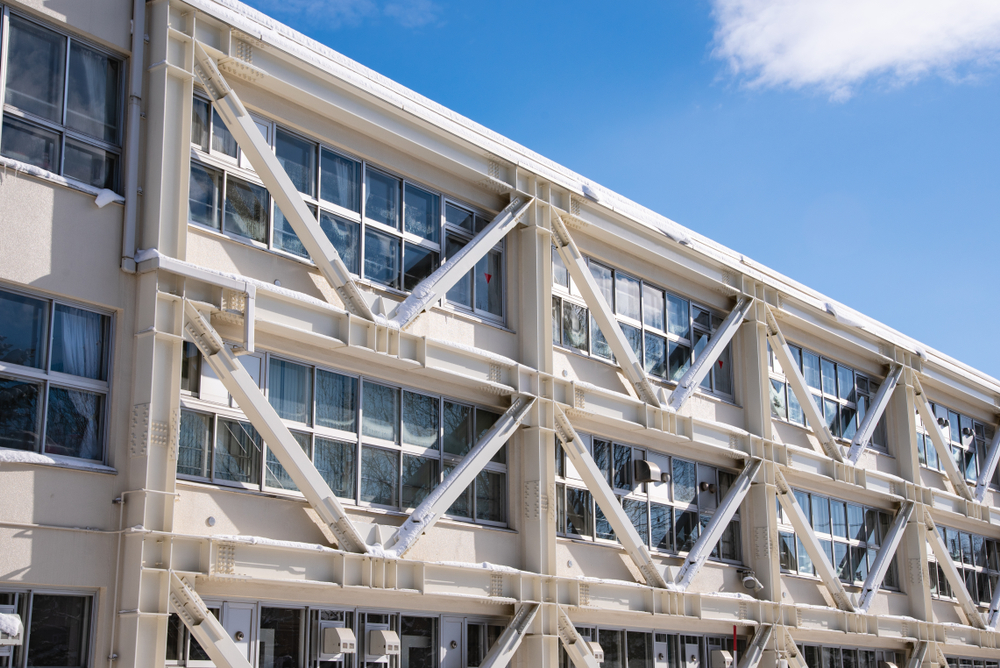Steel’s Use in Tornado Shelters & Other Disaster-Resistant Buildings
July 31, 2023 | Categorized in: Applications

With more than five hurricanes, 15 major earthquakes, and over 800 tornadoes annually in the US alone, disaster-resistant buildings are a necessity for most regions. Various construction methods use steel to reinforce building materials and some shelters are made completely out of steel plating. These methods and structures save countless lives every year.
Benefits of steel in disaster-resistant construction
Not only is steel a cost-effective building material, but it can withstand large amounts of force while retaining its shape. Because of its tensile strength, frameworks and foundations that use steel can bend without breaking. Additionally, steel is inherently resistant to the high temperatures resulting from a fire.
Types of disaster-resilient buildings
Structural steel has many applications for creating buildings that can withstand large amounts of force, scalding heat, and high winds. From steel couplings to mechanical marvels, our infrastructure relies on steel to withstand the harshest events in nature. Tornadoes, hurricanes, earthquakes, and tropical storms each require a unique set of structural components to ensure their fortitude.
Hurricane-proof steel buildings
The lateral force exerted by hurricane winds can tear off roofs and send debris flying through windows. Also, tropical storms are often accompanied by floods that can erode foundations. For these reasons, hurricane-resistant buildings use steel in a wide range of applications such as:
- Hurricane clips – specially designed steel brackets used to hold the trusses of a roof onto walls to combat large gusts of wind.
- Blockwork wall reinforcing – rebar is sunk vertically into a concrete slab and then used to stabilize cinder block walls.
- Reinforced windows – high-impact glass installed between steel framing creates hurricane-proof windows.
- Tie downs – metal bars anchor steel beams in a building’s floor to the foundation.
Tornado shelters
A tornado-safe room must withstand winds up to 250 miles per hour – to do this, two-by-fours are fortified using 14ga (fourteen gauge) steel sheets and hurricane clips. These rooms are easier to install before home construction is completed because significant foundational work must be done beforehand. For buildings in need of a more modular solution, full steel tornado shelters are available and can be installed with minimal labor. These structures feature sliding doors and are made from quarter-inch-thick steel plates. The last option for a tornado shelter is a steel-reinforced basement. Steel cellar doors and concrete braced with rebar are common features of basements in regions with frequent tornadoes.
Earthquake-resistant buildings
Combating the horizontal forces exerted by a large-magnitude earthquake can be tricky, especially when dealing with tall buildings like skyscrapers. To do this, building frameworks need to be flexible and retain their balance. From the foundation and upward, here are a few ways buildings use steel to offset earthquakes:
- Base isolators – composite structures made from steel, silicon, and rubber that absorb the vibrations of earthquakes before they can shake a foundation.
- Steel joints – hinge-like mechanisms used to join steel beams and channels allowing building frames to bend and shift without buckling.
- Pendulums and dampeners – as a taller building sways from lateral forces, a large steel pendulum counteracts the force by swinging in opposition to the momentum.
Flood barriers
To prevent flooding, gates and dams use steel to create drainage systems and walls to repel rising tides. The ease of galvanizing for rust resistance and the relatively low costs of steel make it ideal for flood barriers. Some flood prevention mechanisms incorporate moving parts and inflatable seals between steel walls for added protection.
Fireproofing steel beams
The American Society for Testing and Materials (ASTM) tests steel’s heat resistance with rising temperatures over 1,000 degrees Fahrenheit. Although steel is naturally resilient to high temperatures, 1,000 degrees is about when structural steel begins to lose its form and integrity. A fire is capable of reaching temperatures above this. For this reason, an epoxy-based coating is applied to beams in need of more resistance to heat. The coating inflates under extreme heat and insulates the steel beam underneath.
Find a reliable structural steel distributor
Manufacturers and engineers rely on structural steel to create disaster-resistant buildings that protect families and workers. Therefore, finding suitable materials is equally important as finding a reliable steel distributor.
Steel can withstand large amounts of stress, but you shouldn’t have to when ordering large quantities of steel. At Service Steel, we pride ourselves on delivering fast quotes, customized pricing, and professional shipping services. Request a quote today to start sourcing all the steel you need for your next project!
